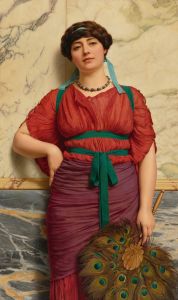
Melissa
A hand-painted replica of John William Godward’s masterpiece Melissa, meticulously crafted by professional artists to capture the true essence of the original. Each piece is created with museum-quality canvas and rare mineral pigments, carefully painted by experienced artists with delicate brushstrokes and rich, layered colors to perfectly recreate the texture of the original artwork. Unlike machine-printed reproductions, this hand-painted version brings the painting to life, infused with the artist’s emotions and skill in every stroke. Whether for personal collection or home decoration, it instantly elevates the artistic atmosphere of any space.
John William Godward was a British painter born on August 9, 1861, in Wimbledon, London. He was a protégé of Sir Lawrence Alma-Tadema, a prominent figure in the Neo-Classicism movement. Godward is best known for his depictions of women in classical settings, often characterized by their serene beauty and meticulous attention to detail. His works typically feature elements of ancient Roman and Greek architecture and attire, reflecting the Victorian fascination with the classical past.
"Melissa" is one of Godward's many paintings that exemplify his style and thematic focus. Created in 1908, this painting showcases Godward's skill in rendering textures and his dedication to classical themes. The painting depicts a young woman, presumably named Melissa, seated in a classical setting. She is adorned in a flowing, richly colored garment, typical of Godward's attention to the drapery and fabric that evoke the classical era. The background often includes elements such as marble, columns, or lush landscapes, which are characteristic of Godward's work and serve to transport the viewer to an idealized ancient world.
Godward's technique is marked by his use of vibrant colors and smooth brushwork, which contribute to the lifelike quality of his subjects. His paintings often convey a sense of tranquility and timeless beauty, capturing the viewer's attention through their harmonious composition and exquisite detail. "Melissa" is no exception, as it reflects Godward's ability to blend realism with an idealized vision of antiquity.
Throughout his career, Godward remained committed to the classical style, even as the art world began to shift towards modernism. This dedication to his artistic vision, however, eventually led to his marginalization in the art community, as movements like Impressionism and Post-Impressionism gained popularity. Despite this, Godward continued to produce works that adhered to his classical ideals until his death in 1922.
Godward's paintings, including "Melissa," are appreciated for their technical precision and aesthetic appeal. They offer a glimpse into the Victorian era's romanticized view of the classical world, reflecting both the artist's personal interests and the broader cultural trends of his time. Today, Godward's works are held in various private collections and museums, where they continue to be admired for their beauty and craftsmanship.
In summary, "Melissa" by John William Godward is a quintessential example of the artist's dedication to classical themes and his mastery of painting techniques. The work captures the serene beauty and timeless elegance that define Godward's oeuvre, making it a valuable piece in the study of Neo-Classicism and the broader history of art.

















